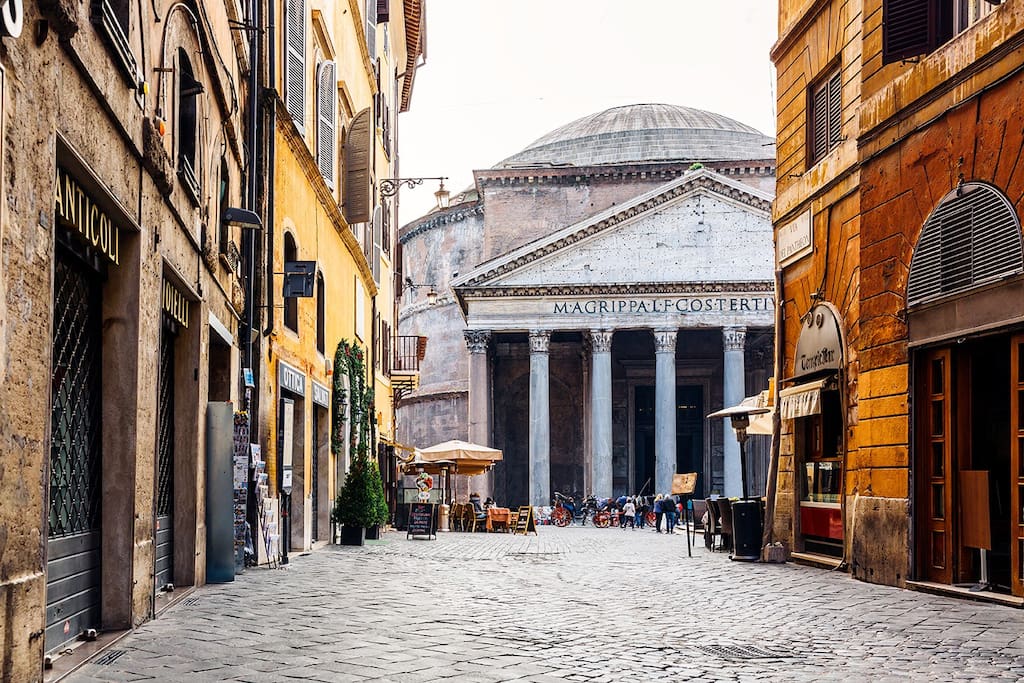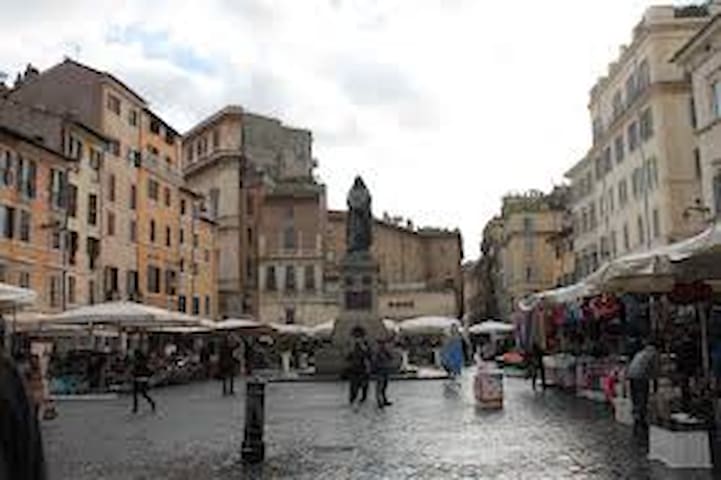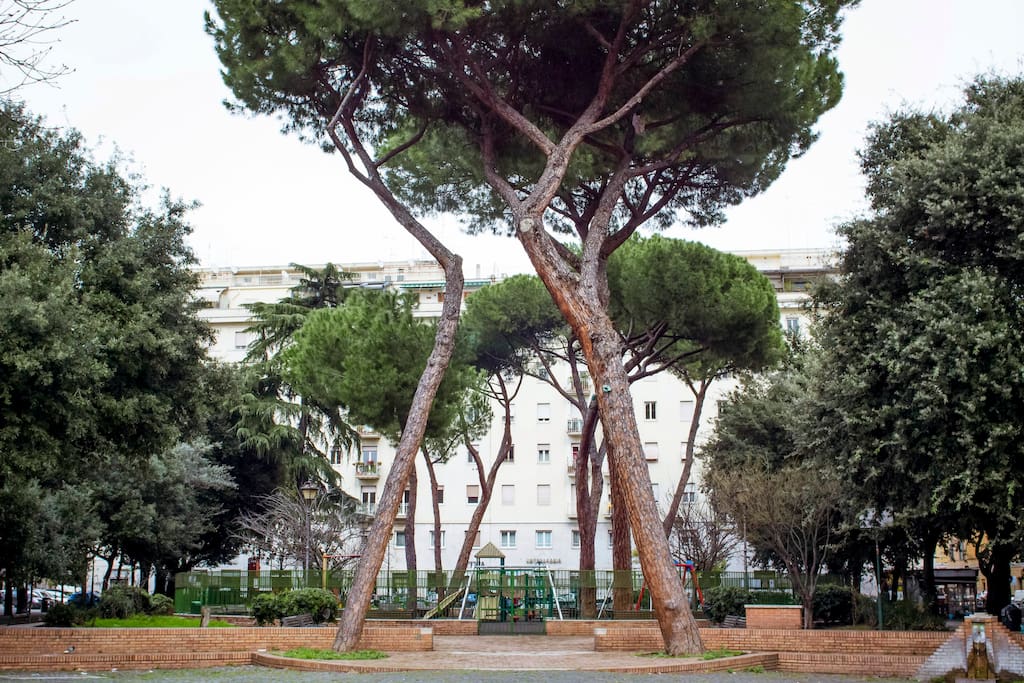Offerta gastronomica
Carrefour Express - Supermarket
83 Via degli Orti della Farnesina
supermarket one minute walk
the real Roman pizza one minute walk from the apartment
279 personas locales recomiendan
Pizzeria Da Baffetto
114 Via del Governo Vecchiothe real Roman pizza one minute walk from the apartment
excellent Roman cuisine restaurant under the apartment
72 personas locales recomiendan
Da Tonino - Trattoria Bassetti
18-19 Via del Governo Vecchio
excellent Roman cuisine restaurant under the apartment
super
all excellent a real restaurant with super things
220 personas locales recomiendan
Roscioli Salumeria con Cucina
21 Via dei Giubbonarisuper
all excellent a real restaurant with super things
Bar del Fico - gypsy style cool
34 Via della Pacedelicious pastry to try sour cherry cakes, ricotta pie
49 personas locales recomiendan
Pasticceria Boccione
1 Via del Portico d'Ottaviadelicious pastry to try sour cherry cakes, ricotta pie
Visite turistiche
The Pantheon [temple] of all the gods") is a former Roman temple, now a church, in Rome, Italy, on the site of an earlier temple commissioned by Marcus Agrippa during the reign of Augustus (27 BC – 14 AD). It was completed by the emperor Hadrian and probably dedicated about 126 AD. Its date of construction is uncertain, because Hadrian chose not to inscribe the new temple but rather to retain the inscription of Agrippa's older temple, which had burned down
1342 personas locales recomiendan
Panthon
Piazza della RotondaThe Pantheon [temple] of all the gods") is a former Roman temple, now a church, in Rome, Italy, on the site of an earlier temple commissioned by Marcus Agrippa during the reign of Augustus (27 BC – 14 AD). It was completed by the emperor Hadrian and probably dedicated about 126 AD. Its date of construction is uncertain, because Hadrian chose not to inscribe the new temple but rather to retain the inscription of Agrippa's older temple, which had burned down
Piazza Navona is a public space/plaza in Rome, Italy. It is built on the site of the Stadium of Domitian, built in the 1st century AD, and follows the form of the open space of the stadium.[1] The ancient Romans went there to watch the agones ("games"), and hence it was known as "Circus Agonalis" ("competition arena"). It is believed that over time the name changed to in avone to navone and eventually to navona.
1722 personas locales recomiendan
Piazza Navona
Piazza NavonaPiazza Navona is a public space/plaza in Rome, Italy. It is built on the site of the Stadium of Domitian, built in the 1st century AD, and follows the form of the open space of the stadium.[1] The ancient Romans went there to watch the agones ("games"), and hence it was known as "Circus Agonalis" ("competition arena"). It is believed that over time the name changed to in avone to navone and eventually to navona.
In Ancient Rome, the area was unused space between Pompey's Theatre and the flood-prone Tiber. Though the Orsini established themselves on the south flank of the space in the 13th century, until the 15th century, the square remained undeveloped. The first church in the immediate vicinity was built during the pontificate of Boniface IX (1389-1404), Santa Brigida a Campo de' Fiori; with the building-up of the rione, the church has now come to face that part of the former square that is now Piazza Farnese. In 1456, under Pope Callixtus III, Ludovico Cardinal Trevisani paved the area as part of a large project to improve rione Parione.
383 personas locales recomiendan
Piazza Campo de' Fiori
Campo de' FioriIn Ancient Rome, the area was unused space between Pompey's Theatre and the flood-prone Tiber. Though the Orsini established themselves on the south flank of the space in the 13th century, until the 15th century, the square remained undeveloped. The first church in the immediate vicinity was built during the pontificate of Boniface IX (1389-1404), Santa Brigida a Campo de' Fiori; with the building-up of the rione, the church has now come to face that part of the former square that is now Piazza Farnese. In 1456, under Pope Callixtus III, Ludovico Cardinal Trevisani paved the area as part of a large project to improve rione Parione.
The Colosseum or Coliseum, also known as the Flavian Amphitheatre (Latin: Amphitheatrum Flavium; Italian: Anfiteatro Flavio or Colosseo, is an oval amphitheatre in the centre of the city of Rome, Italy. Built of travertine limestone, tuff (volcanic rock), and brick-faced concrete,[1] it was the largest amphitheatre ever built at the time and held 50,000 to 80,000 spectators. The Colosseum is situated just east of the Roman Forum. Construction began under the emperor Vespasian in AD 72[2] and was completed in AD 80 under his successor and heir, Titus.[3] Further modifications were made during the reign of Domitian (81–96).[4] These three emperors are known as the Flavian dynasty, and the amphitheatre was named in Latin for its association with their family name (Flavius).
2613 personas locales recomiendan
Colosseum
1 Piazza del ColosseoThe Colosseum or Coliseum, also known as the Flavian Amphitheatre (Latin: Amphitheatrum Flavium; Italian: Anfiteatro Flavio or Colosseo, is an oval amphitheatre in the centre of the city of Rome, Italy. Built of travertine limestone, tuff (volcanic rock), and brick-faced concrete,[1] it was the largest amphitheatre ever built at the time and held 50,000 to 80,000 spectators. The Colosseum is situated just east of the Roman Forum. Construction began under the emperor Vespasian in AD 72[2] and was completed in AD 80 under his successor and heir, Titus.[3] Further modifications were made during the reign of Domitian (81–96).[4] These three emperors are known as the Flavian dynasty, and the amphitheatre was named in Latin for its association with their family name (Flavius).
The Mausoleum of Hadrian, usually known as Castel Sant'Angelo (Italian pronunciation: [kaˈstɛl sanˈtandʒelo]; English: Castle of the Holy Angel), is a towering cylindrical building in Parco Adriano, Rome, Italy. It was initially commissioned by the Roman Emperor Hadrian as a mausoleum for himself and his family. The building was later used by the popes as a fortress and castle, and is now a museum. The structure was once the tallest building in Rome.
1219 personas locales recomiendan
Castel Sant'Angelo
50 Lungotevere CastelloThe Mausoleum of Hadrian, usually known as Castel Sant'Angelo (Italian pronunciation: [kaˈstɛl sanˈtandʒelo]; English: Castle of the Holy Angel), is a towering cylindrical building in Parco Adriano, Rome, Italy. It was initially commissioned by the Roman Emperor Hadrian as a mausoleum for himself and his family. The building was later used by the popes as a fortress and castle, and is now a museum. The structure was once the tallest building in Rome.
The Papal Basilica of St. Peter in the Vatican (Italian: Basilica Papale di San Pietro in Vaticano), or simply St. Peter's Basilica (Latin: Basilica Sancti Petri), is a church built in the Renaissance style located in Vatican City, the papal enclave which is within the city of Rome.
Designed principally by Donato Bramante, Michelangelo, Carlo Maderno and Gian Lorenzo Bernini, St. Peter's is the most renowned work of Renaissance architecture[2] and the largest church in the world.[3] While it is neither the mother church of the Catholic Church nor the cathedral of the Diocese of Rome, St. Peter's is regarded as one of the holiest Catholic shrines. It has been described as "holding a unique position in the Christian world"[4] and as "the greatest of all churches of Christendom"
564 personas locales recomiendan
Vatican City
The Papal Basilica of St. Peter in the Vatican (Italian: Basilica Papale di San Pietro in Vaticano), or simply St. Peter's Basilica (Latin: Basilica Sancti Petri), is a church built in the Renaissance style located in Vatican City, the papal enclave which is within the city of Rome.
Designed principally by Donato Bramante, Michelangelo, Carlo Maderno and Gian Lorenzo Bernini, St. Peter's is the most renowned work of Renaissance architecture[2] and the largest church in the world.[3] While it is neither the mother church of the Catholic Church nor the cathedral of the Diocese of Rome, St. Peter's is regarded as one of the holiest Catholic shrines. It has been described as "holding a unique position in the Christian world"[4] and as "the greatest of all churches of Christendom"
In the middle of the square is the famous Fontana della Barcaccia, dating to the beginning of the baroque period, sculpted by Pietro Bernini and his son, the more famous Gian Lorenzo Bernini.
At the right corner of the Spanish Steps rises the house of the English poet John Keats, who lived there until his death in 1821: nowadays it has been changed into a museum dedicated to him and his friend Percy Bysshe Shelley, displaying books and memorabilia of English romanticism. At the left corner there is the Babington's tea room, founded in 1893.
The side near Via Frattina is overlooked by the two façades (the main one, designed by Gian Lorenzo Bernini, and the side one created by Francesco Borromini) of the Palazzo di Propaganda Fide, a property of the Holy See. In front of it, actually in a lengthening of Piazza di Spagna named Piazza Mignanelli, rises the Column of the Immaculate Conception, erected in 1856, two years after the proclamation of the dogma.
1307 personas locales recomiendan
Piazza di Spagna
Piazza di SpagnaIn the middle of the square is the famous Fontana della Barcaccia, dating to the beginning of the baroque period, sculpted by Pietro Bernini and his son, the more famous Gian Lorenzo Bernini.
At the right corner of the Spanish Steps rises the house of the English poet John Keats, who lived there until his death in 1821: nowadays it has been changed into a museum dedicated to him and his friend Percy Bysshe Shelley, displaying books and memorabilia of English romanticism. At the left corner there is the Babington's tea room, founded in 1893.
The side near Via Frattina is overlooked by the two façades (the main one, designed by Gian Lorenzo Bernini, and the side one created by Francesco Borromini) of the Palazzo di Propaganda Fide, a property of the Holy See. In front of it, actually in a lengthening of Piazza di Spagna named Piazza Mignanelli, rises the Column of the Immaculate Conception, erected in 1856, two years after the proclamation of the dogma.
Testaccio is the 20th rione of Rome, deriving its name from Monte Testaccio. It is located in the city's Municipio I.
In antiquity, much of the Tiber River trade took place here, and the remains of broken clay vessels (amphorae) were stacked creating the artificial Testaccio hill, which today is a source of much archeological evidence as to the history of ancient everyday Roman life. The rione seal depicts one of these amphorae. In modern times, the area has been a center of activity for butchers. Testaccio was one of Rome’s traditional working class neighborhoods, but the recent process of gentrification has made it increasingly attractive to tourists.[1] The neighborhood is home to several of Rome's culinary highlights. Testaccio's reputation among tourists is expanding
223 personas locales recomiendan
Monte Testaccio
Testaccio is the 20th rione of Rome, deriving its name from Monte Testaccio. It is located in the city's Municipio I.
In antiquity, much of the Tiber River trade took place here, and the remains of broken clay vessels (amphorae) were stacked creating the artificial Testaccio hill, which today is a source of much archeological evidence as to the history of ancient everyday Roman life. The rione seal depicts one of these amphorae. In modern times, the area has been a center of activity for butchers. Testaccio was one of Rome’s traditional working class neighborhoods, but the recent process of gentrification has made it increasingly attractive to tourists.[1] The neighborhood is home to several of Rome's culinary highlights. Testaccio's reputation among tourists is expanding






